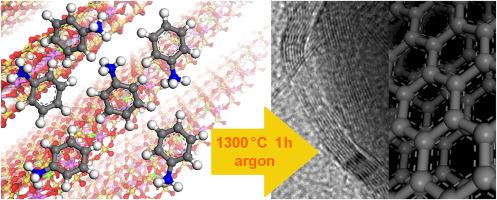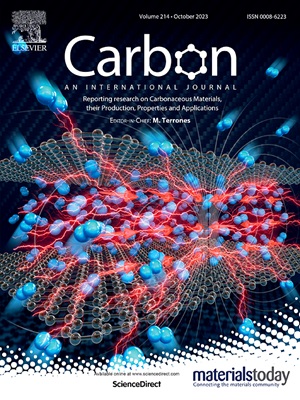Graphite and multi-layer graphene from a low molecular weight carbon source
IF 10.5
2区 材料科学
Q1 CHEMISTRY, PHYSICAL
引用次数: 0
Abstract
While carbonaceous structures formed by pyrolysis of macromolecular carbon sources with silicates are well described in the literature, information on the structure of carbons obtained in the similar way from low molecular weight (LMW) carbon sources is not sufficient. This study is therefore aimed at characterizing the material obtained by pyrolyzing (1300 °C; Ar atmosphere) montmorillonite containing ∼25–50 wt% LMW cations as a carbon source. Pyrolyzed samples contained ∼5–20 wt% carbon, and thermogravimetric and elemental analysis showed a higher yield for a higher original amount of the LMW carbon source. In addition to amorphous carbon, graphite was formed during pyrolysis, as confirmed by X-ray diffraction analysis, Raman spectroscopy, and X-ray photoelectron spectroscopy. The presence of graphene-based nanomaterial, specifically multi-layer graphene, was revealed by transmission electron microscopy (TEM). Electrical conductivity of the silicate/carbon material reached ∼35 S m−1. Raman spectra and TEM images are similar to those from studies describing the use of macromolecular carbon sources. LMW compounds are a sufficient source of carbon for the preparation of electrically conductive materials containing graphite and multi-layer graphene.

来自低分子量碳源的石墨和多层石墨烯
虽然文献中对大分子碳源与硅酸盐热解形成的碳质结构进行了详细描述,但有关低分子量(LMW)碳源以类似方式获得的碳质结构的信息却并不充分。因此,本研究旨在分析通过热解(1300 °C;氩气环境)含 ∼25-50 wt% 低分子量阳离子的蒙脱石作为碳源获得的材料的特征。热解样品含碳量为 5-20 wt%,热重分析和元素分析表明,LMW 碳源原始含量越高,产量越高。X 射线衍射分析、拉曼光谱和 X 射线光电子能谱证实,在热解过程中,除无定形碳外,还形成了石墨。透射电子显微镜(TEM)显示了石墨烯基纳米材料的存在,特别是多层石墨烯。硅酸盐/碳材料的电导率达到了 35 S m-1。拉曼光谱和 TEM 图像与使用大分子碳源的研究结果相似。低分子量化合物是制备含有石墨和多层石墨烯的导电材料的充足碳源。
本文章由计算机程序翻译,如有差异,请以英文原文为准。
求助全文
约1分钟内获得全文
求助全文
来源期刊

Carbon
工程技术-材料科学:综合
CiteScore
20.80
自引率
7.30%
发文量
0
审稿时长
23 days
期刊介绍:
The journal Carbon is an international multidisciplinary forum for communicating scientific advances in the field of carbon materials. It reports new findings related to the formation, structure, properties, behaviors, and technological applications of carbons. Carbons are a broad class of ordered or disordered solid phases composed primarily of elemental carbon, including but not limited to carbon black, carbon fibers and filaments, carbon nanotubes, diamond and diamond-like carbon, fullerenes, glassy carbon, graphite, graphene, graphene-oxide, porous carbons, pyrolytic carbon, and other sp2 and non-sp2 hybridized carbon systems. Carbon is the companion title to the open access journal Carbon Trends. Relevant application areas for carbon materials include biology and medicine, catalysis, electronic, optoelectronic, spintronic, high-frequency, and photonic devices, energy storage and conversion systems, environmental applications and water treatment, smart materials and systems, and structural and thermal applications.
 求助内容:
求助内容: 应助结果提醒方式:
应助结果提醒方式:


